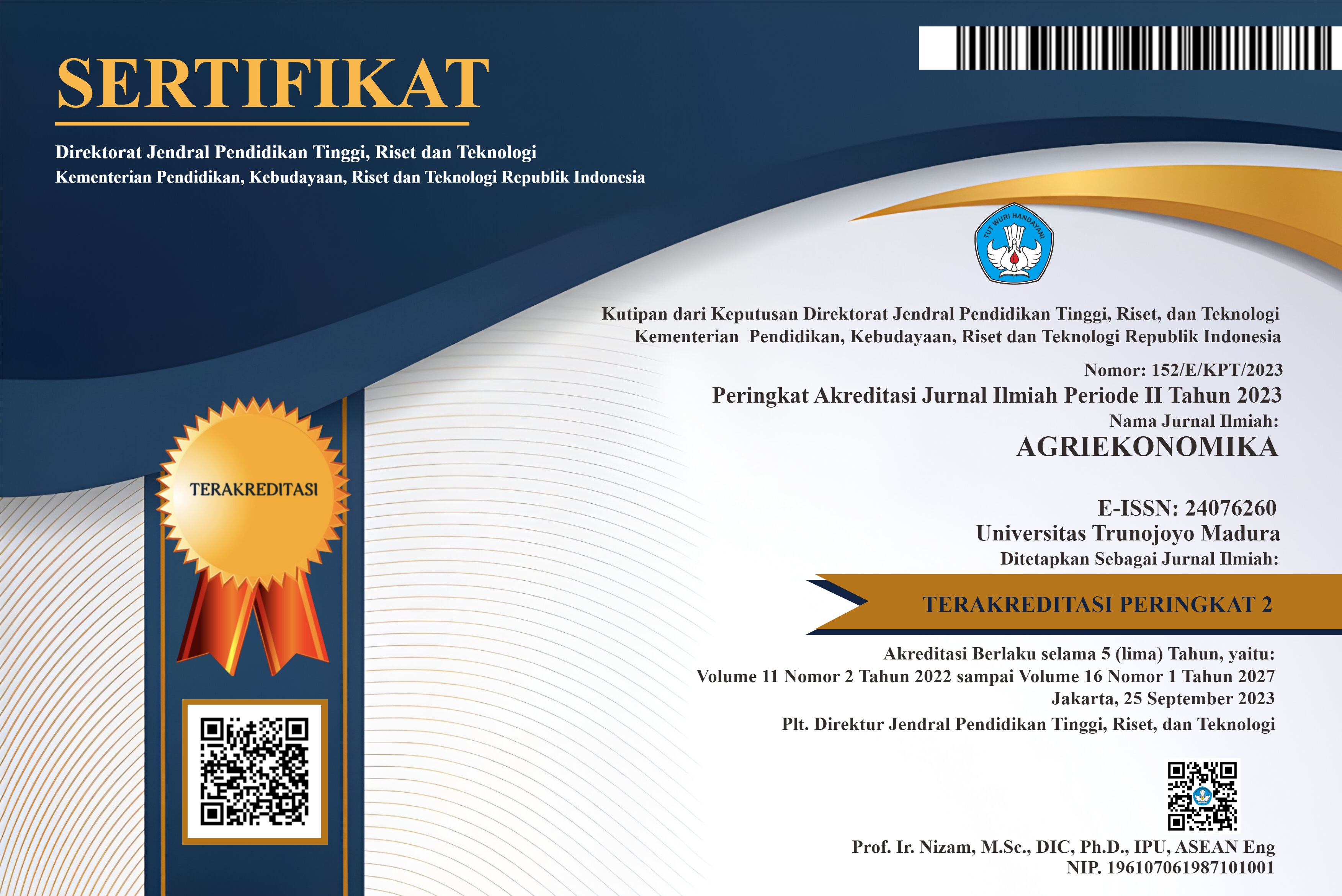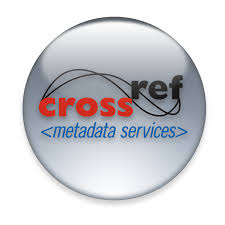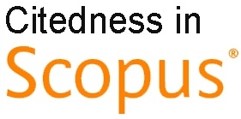Farmers’ Perception for Bio-Slurry Fertilizer in Central Java
Abstract
Bio-slurry is an organic fertilizer derived from the residual waste of biogas processing. This study aims to: 1) find out farmers’ perception of bio-slurry fertilizer, 2) determine the socio-economic characteristics of farmers who confirm to adopt bio-slurry fertilizer in the future. The study was conducted from January to February 2020 in Central Java. Determination of location was purposive with the consideration that farmers in Magelang and Demak Regency, who had utilized biogas waste and commercialized it. Primary data was obtained from 80 by accidental sampling. Data analysis used the attributes of innovation: relative advantage, compatibility, complexity, trialability, and observability to measure farmers’ perceptions and cross tabs to determine the distribution of confirmation to adopting/stop adopting bio-slurry fertilizers. The results showed that farmers’ perceptions of the relative advantage and trialability of bio-slurry fertilizer were moderately satisfied, completely satisfied perceptions of compatibility, very satisfied with the complexity, and observability of using bio-slurry fertilizers. Respondents who confirmed to adopt bio-slurry fertilizer had characteristics: 1) income of around IDR 2,100,000-3,000,000/month and >Rp. 5,000,000/month; 2) have a high school level education; 3) have land ownership area <0.5 ha; 4) have an age between 41-50 years, and 5) have 3-4 family members. Farmer satisfaction level indicates the good opportunity to survive in the market by taking into account quality.
Keywords
Full Text:
PDFReferences
Adityawarman, A. C., Salundik & Lucia. (2015). Pengolahan Limbah Ternak Sapi Secara Sederhana di Desa Pattalassang Kabupaten Sinjai Sulawesi Selatan. Jurnal Ilmu Produksi dan Teknologi Hasil Peternakan, 3(3), 171–177. doi.org/10.29244/jipthp.3.3.
Adnan, N., Nordin, S. M., Bahruddin, M. A., & Tareq, A. H. (2019). A state-of-the-art review on facilitating sustainable agriculture through green fertilizer technology adoption: Assessing farmers behavior. Trends in Food Science and Technology, 86, 439–452. doi.org/10.1016/j.tifs.2019.02.040
Akudugu, M. A., Guo, E., & Dadzie, S. K. (2012). Adoption of Modern Agricultural Production Technologies by Farm Households in Ghana: What Factors Influence their Decisions? Journal of Biology, Agriculture and Healthcare, 2(3), 1–13.
Asnamawati, L. (2015). Strategi Percepatan Adopsi dan Difusi Inovasi Dalam Pemanfaatan Mesin Tanam Padi Idojarwo Tansplanter Di Kabupaten Bengkulu Utara Provinsi Bengkulu. Prosiding Seminar Nasional FMIPA-UT 2015, 210–225. http://repository.ut.ac.id/1613/1/fmipa2015_17.pdf
Aubert, B. A., Schroeder, A., & Grimaudo, J. (2012). IT as enabler of sustainable farming: An empirical analysis of farmers’ adoption decision of precision agriculture technology. Decision Support Systems, 54(1), 510–520. doi.org/10.1016/j.dss.2012.07.002
Baffoe-Asare, R., Abrefa, J. D. & Annor-Frempong, F. (2013). Socioeconomic Factors Influencing Adoption of Codapec and Cocoa High-tech Technologies among Small Holder Farmers in Central Region of Ghana. American Journal of Experimental Agriculture, 3(2), 277–292. doi.org/10.9734/ajea/2013/1969
Caffaro, F., Micheletti Cremasco, M., Roccato, M., & Cavallo, E. (2020). Drivers of farmers’ intention to adopt technological innovations in Italy: The role of information sources, perceived usefulness, and perceived ease of use. Journal of Rural Studies, 76, 264–271. doi.org/10.1016/j.jrurstud.2020.04.028
Challa, M., & Tilahun, U. (2014). Determinants and Impacts of Modern Agricultural Technology Adoption in West Wollega: The Case of Gulliso District. Journal of Biology, Agriculture and Healthcare, 4(20), 63–77.
D’Antoni, J. M., Mishra, A. K., & Joo, H. (2012). Farmers’ perception of precision technology: The case of autosteer adoption by cotton farmers. Computers and Electronics in Agriculture, 87, 121–128. doi.org/10.1016/j.compag.2012.05.017
Fra̧c, M., Oszust, K., & Lipiec, J. (2012). Community level physiological profiles (CLPP), characterization and microbial activity of soil amended with dairy sewage sludge. Sensors, 12(3), 3253–3268. doi.org/10.3390/s120303253
Hendrawati, E., Yurisnthae, E. & Radian. (2014). Analisis Persepsi Petani Dalam Penggunaan Benih Padi Unggul di Kecamatan Muara Pawan Kabupaten Ketapang. Jurnal Social Economi of Agriculture, 3(1), 53-57.
Hermawati, U., Ihsaniyati, H. dan Utami, B. W. (2016). Persepsi Petani Terhadap Karakteristik Pupuk Organik Cair Limbah Etanol di Kecamatan Mojolaban. AGRISTA. 4(3), 1-12.
Insam, H., Gómez-Brandón, M., & Ascher, J. (2015). Manure-based biogas fermentation residues - Friend or foe of soil fertility? Soil Biology and Biochemistry, 84, 1–14. doi.org/10.1016/j.soilbio.2015.02.006
Kariyasa, K., & Dewi, Y. A. (2013). Analysis Of Factors Affecting Adoption Of Integrated Crop Management Farmer Field School ( ICM-FFS ) In Swampy Areas. International Journal of Food and Agricultural Economics, 1(2), 29–38.
Massah, J., & Azadegan, B. (2016). Effect of chemical fertilizers on soil compaction and degradation. AMA, Agricultural Mechanization in Asia, Africa and Latin America, 47(1), 44–50.
McFadden, J. R., & Huffman, W. E. (2017). Willingness-to-pay for natural, organic, and conventional foods: The effects of information and meaningful labels. Food Policy, 68, 214–232. doi.org/10.1016/j.foodpol.2017.02.007
Mignouna, D. B., Manyong, V. M., Rusike, J., Mutabazi, K. D. S., & Senkondo, E. M. (2011). Determinants of adopting imazapyr-resistant maize technologies and its impact on household income in Western Kenya. AgBioForum, 14(3), 158–163.
Mohammed, S. B., Mohammad, I. F., Pangirayi, T. B., Vernon, G., Dzidzienyo, D. K., Umar, M. L., & Umar, S. (2020). Farmers’ knowledge, perception, and use of phosphorus fertilization for cowpea production in Northern Guinea Savannah of Nigeria. Heliyon, 6(10), e05207. doi.org/10.1016/j.heliyon.2020.e05207
Mwangi, M., & Kariuki, S. (2015). Factors Determining Adoption of New Agricultural Technology by Smallholder Farmers in Developing Countries. Issn, 6(5), 2222–1700. www.iiste.org
Nabinta, A. R., & Muntaka, R. T. (2015). Adoption of Innovative Cowpea Production Practices in a Rural Area of Katsina State , Nigeria. 3(June), 53–58.
Noppers, E. H., Keizer, K., Milovanovic, M., & Steg, L. (2016). The Importance of Instrumental, Symbolic, and Environmental Attributes for the Adoption of Smart Energy Systems. Energy Policy, 98, 12–18. doi.org/10.1016/j.enpol.2016.08.007.
Rogers, E. M. (2018). The Diffusion of Innovations (5th edition). New York(US): The Free Press.
Rodríguez-Entrena, M., & Arriaza, M. (2013). Adoption of Conservation Agriculture in Olive Groves: Evidences from southern Spain. Land Use Policy, 34, 294–300. doi.org/10.1016/j.landusepol.2013.04.002
Roussy, C., Ridier, A., & Chaib, K. (2017). Farmers’ Innovation Adoption Behaviour: Role of Perceptions and Preferences. International Journal of Agricultural Resources, Governance and Ecology, 13(2), 138–161. doi.org/10.1504/IJARGE.2017.086439
Savci, S. (2012). An Agricultural Pollutant: Chemical Fertilizer. International Journal of Environmental Science and Development, 73–80. doi.org/10.7763/ijesd.2012.v3.191
Suhendrik, Agus Wicaksono, I., & Panuntun Utami, D. (2013). Keputusan Petani Dalam Melakukan Usahatani Kedelai (Glycine Max L Merill) di Kecamatan Pituruh Kabupaten Purworejo (Studi Kasus Sekolah Lapangan Pengelolaan Tanaman Terpadu Kedelai di Kecamatan Pituruh). Surya Agritama, 2(2), 1–12.
Syikhristani. (2018). Pengaruh Faktor Individu dan Lingkungan Manajemen Terhadap Kinerja Karyawan Usaha Kecil Briket Tempurung Kelapa di Desa Bangunharjo, Kabupaten Bantul. Thesis. Universitas Gadjah Mada.
Tim Biru dan Yayasan Rumah Energi. (2016). Pedoman, Pengelolaan dan Pemanfaatan Bio-Slurry. Jakarta: Tim Biogas Rumah (BIRU) dan Yayasan Rumah Energi (YRE).
Trischler, J., Johnson, M., & Kristensson, P. (2020). A service ecosystem Perspective on the Diffusion of Sustainability-Oriented User Innovations. Journal of Business Research, 116, 552–560. doi.org/10.1016/j.jbusres.2020.01.011
Warnaen, A., Cangara, H., & Bulkis, S. (2013). Faktor-faktor yang Menghambat Komunikasi Pada Komunitas Petani dan Nelayan Dalam Meningkatkan Kesejahteraan Masyarakat di Kabupaten Takalar. Kareba, 2(3), 241-250.
DOI: https://doi.org/10.21107/agriekonomika.v10i2.11495
Refbacks
- There are currently no refbacks.







